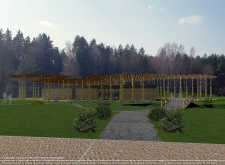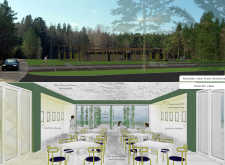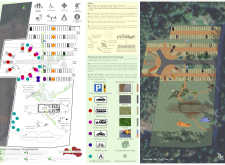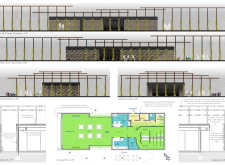5 key facts about this project
At its core, the project is geared towards multifunctionality, accommodating a range of activities that promote community interaction and engagement. This is particularly significant in urban development, where the potential for shared spaces can greatly enhance social connectivity. The design embraces open-plan layouts, allowing for fluid transitions between different areas while maximizing natural light and ventilation. This consideration for environmental factors is evident throughout the architectural design and illustrates a commitment to responsible building practices.
The architectural language employed is characterized by a modern vernacular that respects the historical context of its surroundings. The facade, a key focal point of the project, employs a material palette that includes sustainable options such as recycled metal, locally sourced timber, and glass that enhances energy efficiency. These choices are instrumental in reducing the building's carbon footprint while providing a contemporary aesthetic that resonates with both residents and visitors. The textural interplay between the materials not only adds visual interest but also contributes to the building’s overall performance in terms of thermal comfort and acoustics.
Unique design approaches can be seen in the incorporation of green spaces within the architectural layout. Rooftop gardens and vertical greenery not only serve aesthetic purposes but also function as natural insulators, aiding in temperature regulation and improving air quality. Such elements reflect a growing trend in architecture to incorporate biophilic design principles, contributing to the well-being of occupants while fostering biodiversity within urban environments. The integration of these features illustrates an understanding of the necessity of ecological sustainability in today’s architectural practice.
Details such as the choice of window placements, which are strategically designed to frame specific views or reflect the solar path, play an integral role in enhancing occupant experience. The use of expansive glass sections allows for expansive views and a connection to the outdoor landscape, blurring the lines between interior and exterior spaces. This intentional design approach fosters a deeper sense of place, encouraging residents to engage with their environment more fully.
In terms of accessibility, the project incorporates universal design principles, ensuring that all spaces are navigable for individuals of varying abilities. This focus on inclusivity is an important consideration, as it promotes a sense of belonging within the community and affirms the design’s commitment to social responsibility.
Moreover, the architectural plans reveal a well-researched integration of innovative structural techniques that allow for flexibility in usage. As the demands of urban living continue to evolve, the adaptability embedded within the layout prepares the space for future needs, signaling a forward-thinking perspective in architectural design.
Overall, this project stands as a testament to contemporary architectural practice that not only embraces modern design ideas but also grounds them in functionality and sustainability. The thematic elements resonating throughout the design offer a blueprint for future developments in the area. For readers interested in a more granular look at this ambitious endeavor, a detailed examination of the architectural plans, sections, designs, and ideas will provide a richer understanding of how this project not only meets current needs but also sets a precedent for future architectural explorations. Explore the project presentation for a deeper insight into its many layers and complexities.


























